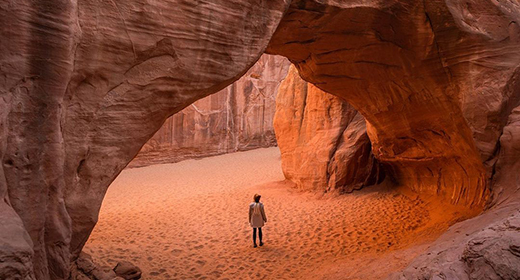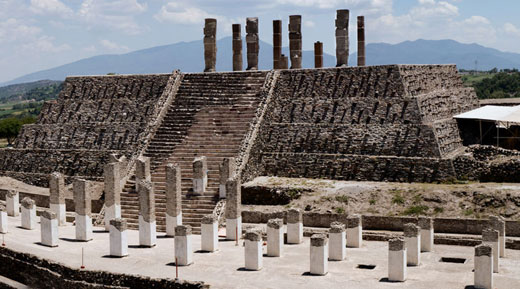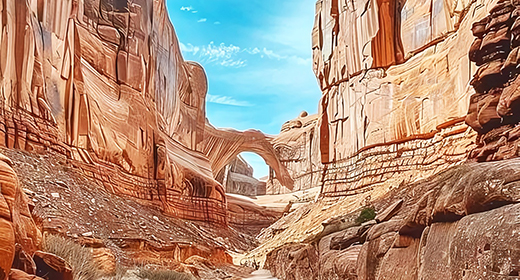by Jeff Goodell: One thing that’s hard to grasp about the climate crisis is that big changes can happen fast…
In 2019, I was aboard the Nathaniel B. Palmer, a 308-foot-long scientific research vessel, cruising in front of the Thwaites Glacier in Antarctica. One day, we were sailing in clear seas in front of the glacier. The next day, we were surrounded by icebergs the size of aircraft carriers.
As we later learned from satellite images, in a matter of 48 hours or so, a mélange of ice about 21 miles wide and 15 miles deep had cracked up and scattered into the sea.
It was a spooky moment. Thwaites Glacier is the size of Florida. It is the cork in the bottle of the entire West Antarctic ice sheet, which contains enough ice to raise sea levels by 10 feet. The mélange that disintegrated was not part of the glacier itself, but a mix of icebergs and sea ice that had cozied up next to it. Still, the idea that it could just fall apart overnight was mind-blowing.
As it turns out, the ice breakup I witnessed was not a freak event. A few weeks ago, scientists participating in the International Thwaites Glacier Collaboration, a $25 million five-year-long joint research program between the National Science Foundation in the U.S. and the Natural Environment Research Council in the U.K., presented their latest research. They described the discovery of cracks and fissures in the Thwaites eastern ice shelf, predicting that the ice shelf could fracture like a shattered car window in as little as five years. “It won’t scatter out into sea as quickly as what you saw when you were down there,” Erin Pettit, a glaciologist at Oregon State University and one of the lead principal investigators in the ITGC, later told me. “But the basic process is the same. The ice shelf is breaking up and could be gone in less than a decade.”
Given the ongoing war for American democracy and the deadly toll of the Covid pandemic, the loss of an ice shelf on a far-away continent populated by penguins might not seem to be big news. But in fact, the West Antarctic ice sheet is one of the most important tipping points in the Earth’s climate system. If Thwaites Glacier collapses, it opens the door for the rest of the West Antarctic ice sheet to slide into the sea. Globally, 250 million people live within three feet of high tide lines. Ten feet of sea level rise would be a world-bending catastrophe. It’s not only goodbye Miami, but goodbye to virtually every low-lying coastal city in the world.
But predicting the breakup of ice sheets and the implications for future sea level rise is fraught with uncertainty. Depending on various emissions scenarios in the latest Intergovernmental Panel on Climate Change report, we could have as little as one foot of sea level rise by the end of the century, or nearly six feet of sea level rise (of course, rising seas won’t stop in 2100, but that date has become a common benchmark). “The difference between those [models] is a lot of lives and money,” says Richard Alley, a glaciologist at Penn State University and one of the great ice scientists of our time. Alley adds: “The most likely place to generate [the worst scenario] is Thwaites.”
Or to put it more urgently: “If there is going to be a climate catastrophe,” Ohio State glaciologist Ian Howat once told me, “it’s probably going to start at Thwaites.”
The problem is, understanding what’s going on at Thwaites is fiendishly complex. As I wrote in 2017:
The trouble with Thwaites, which is one of the largest glaciers on the planet, is that it’s also what scientists call “a threshold system.” That means instead of melting slowly like an ice cube on a summer day, it is more like a house of cards: It’s stable until it is pushed too far, then it collapses.
Thwaites is very different from other big glaciers, such as those in Greenland. For one thing, it is not melting from above, due to warmer air temperatures. It’s melting from below, due to warmer ocean water eating away at its underbelly. More importantly, the terrain beneath the West Antarctic ice sheet is peculiar. “Think of it as a giant soup bowl filled with ice,” Sridhar Anandakrishnan, an expert in polar glaciology at Penn State University, once told me. In the bowl analogy, the edge of the glacier — the spot where a glacier leaves the land and begins to float — is perched on the lip of the bowl 1,000 feet or more below sea level. Scientists call that lip the “grounding line.” Below the lip, the terrain falls away on a downward slope for hundreds of miles, all the way to the Transantarctic Mountains that divide East and West Antarctica. At the deepest part of the basin, the ice is about two miles thick.
What this means is that once the warm water gets below ice, it can flow down the slope of the bowl, weakening the ice from below. Through a mechanism called “marine ice-cliff Instability,” you can get what amounts to a runaway collapse of the ice sheet that could raise global sea levels very high, very fast.
That’s why, when I wrote my 2017 Rolling Stone story about Thwaites, I dubbed it “The Doomsday Glacier.” (The name stuck — if you type the phrase into Google now, you get half a million hits.)
In a worst-case scenario, how fast could Thwaites collapse? No one knows. The IPCC data is the best guide for sea level rise for the rest of this century, although Alley cautions me that even six feet of sea level rise by 2100 is not the worst-case scenario.
“We just don’t know what the upper boundary is for how fast this can happen,” Alley says. “We are dealing with an event that no human has ever witnessed before. We have no analog for this.”
In the past few years, scientists have made a lot of progress in understanding the dynamics of Thwaites. On our 2019 cruise, scientists discovered troughs in the seabed that allowed warm water to flow underneath the ice shelf. Scientists have mapped the underside of the glacier itself, tracked crevasses in the ice shelf, and located pinning points that might slow the retreat of the ice. The change has been dramatic: “The net rate of ice loss from Thwaites Glacier is more than six times what it was in the early 1990s,” says Rob Larter, a geophysicist with the British Antarctic Survey who was the chief scientist on my trip to Antarctica in 2019.
The recent news about Thwaites’ eastern ice shelf breaking up in the next five years was not really a surprise to anyone who has been tracking the science closely. After the sudden disintegration of the Larsen B ice shelf in 2002, scientists realized that Antarctica was far less stable than many had believed. The discovery of cracks and fissures at Thwaites further underscore just how dynamic the changes already underway are.
Erin Pettit
To be clear, there is a big difference between an ice shelf and the glacier itself. The ice shelf is like a thumbnail that grows out from the glacier and floats on the ocean. Because it is already floating, when it melts it doesn’t in itself contribute to sea level rise (just as when ice cubes melt in your glass, they don’t raise the level of liquid).
But ice shelves are important because they buttress glaciers. Like the flying buttresses of Notre Dame, they give the walls of ice stability. And when they break up, the land-based glacier is free to flow much faster into the sea. And that does raise sea levels.
So yeah, if Thwaites loses a significant part of its ice shelf in five years, that’s a big deal.
But even if a big part of the ice shelf does crack up, there is a lot of unknown complexity in how it will play out. “A first question is, if the ice-shelf breakage continues, will the whole ice shelf be lost, or will a short ice shelf remain, at least in some places?” Richard Alley emailed me. “Almost all ice-shelf ice is buttressing, generating friction that holds back the non-floating ice, so loss of part, most or all of the ice shelf will increase flow of non-floating ice into the ocean. But the most-important buttressing tends to arise closest to the grounding zone, so if a short ice shelf does remain, it may still provide important buttressing, and the speedup of flow and thinning will be smaller than they could be with full ice-shelf loss.”
Here you see the problem. Even predicting how the crackup of the ice shelf will impact the flow of the glacier is difficult to estimate.
And this is only one of the uncertainties that scientists face when trying to predict whether or not Miami will be underwater by 2100. There is further uncertainty in exactly where and when the ice will fracture, how much warm water will be pushed up beneath the glacier by changing winds and ocean currents, how the character of the bed the glacier rests on will speed up or slow down the glacier’s slide into the sea. Whether the bed is hard rock or muddy till can have a big impact on the velocity of the glacier, just as the texture of snow affects how fast you ski down a mountain. “Ice is alive,” says Pettit. “It moves and flows and breaks in ways that are difficult to anticipate.”
Paradoxically, the more scientists learn about what’s going on at Thwaites, the more divergent the latest climate models have become about its future. Consider the results of two models by highly respected scientists published side by side in Nature earlier this year. One model suggests that Thwaites stays fairly stable until temperatures rise above 2 C of warming. Then all hell breaks loose. Thwaites begins to fall into the sea like a line of dominoes pushed off a table and soon takes the rest of the West Antarctic ice sheet with it. And once the collapse begins, according to this model, it will be impossible to stop — at least on any human time scale. In a century or so, global sea levels could rise 10 feet, which would swamp South Florida and Bangladesh and many other low-lying regions of the world.
In the other model, global sea level rise only differs by 4½ inches between a 1.5 C global temperature rise and a 3 C temperature rise (which is a little above where we are headed with under current emissions scenarios). And much of that comes from increased melt in Greenland and mountain glaciers. As for Antarctica, the paper says explicitly: “No clear dependence on emissions scenario emerges for Antarctica.”
So what to make of all this?
“The current divergence among model predictions is actually a good sign because it means that scientists are probing different parameterizations, representations of processes, and hypotheses,” writes Jeremy Bassis, a geophysicist at the University of Michigan. Bassis suggests not focusing so much on the long-term uncertainty and highlighting instead what scientists know about the next few decades. “The skill of models in predicting sea level change on decadal time scales is high, and we already have actionable projections on these time scales. We should be emphasizing that fact in discussions with community members, stakeholders, and decision-makers, so they can move ahead with important adaptation and mitigation planning.”
But in the long run, it is not clear that the dynamics of ice sheet collapse that are underway at Thwaites can be stopped. As glaciologist Eric Rignot put it in 2015, in Antarctica, “the fuse has been blown.” Even if we cut carbon emissions to zero tomorrow, warm water will continue to flow beneath the ice sheet for decades, destabilizing the ice and further pushing the glacier toward eventual collapse. This doesn’t means that cutting carbon pollution to zero isn’t an important goal — nothing, in fact, is more important or more urgent. “We may have a small safety margin in Antarctica, but not a large one,” says Alley. Even if the fuse is blown, cutting emissions fast could slow it all down to a millennium-long crack-up that will give us more time to adapt. One way or another, our future is written in ice.











































